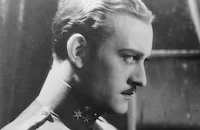Based on a popular stage play, The Thirteenth Chair begins with a seance called by Edward Wales to trap the killer of his friend. Most of the 13 participants in the seance had a motive and a means to commit the murder. Wales knows he is on the right track when one of them kills again under the cover of darkness. The suspects are played by a virtual who's-who of recognizable character actors: Conrad Nagel, who emceed MGM's first sound musical extravaganza The Hollywood revue of 1929 (1929); Leila Hyams, later Venus in Browning's Freaks; and reprising her stage role as the medium, Margaret Wycherly, memorably evil as James Cagney's Ma Jarrett in White Heat (1949). Future leading man Joel McCrea also had a part, but his scenes were deleted before the film's release.
The focus of the film shifts decisively to Bela Lugosi when he makes his entrance as Inspector Delzante. Lugosi had built a noteworthy career as a stage and film actor in his native Hungary in the early part of the 20th century. Because of his efforts to organize an actors union, a radical activity at the time, he was forced to flee to Germany, where he continued to make films and gain status as a matinee idol. His first American film was The Silent Command (1923). He made a number of silent film appearances before his runaway success on Broadway in Dracula. This was his first venture with Browning. Two years later, the director cast him in the film version of the Bram Stoker vampire tale after Chaney, Browning's first choice for the role, died. Lugosi and Browning made one other film together, Mark of the Vampire (1935), in which he played Count Mora, a knock-off of his more famous blood-sucking cousin.
Director: Tod Browning
Screenplay: Elliott J. Clawson, Joseph Farnham, based on the play by Bayard Veiller
Cinematography: Merritt B. Gerstad
Editing: Harry Reynolds
Art Direction: Cedric Gibbons
Costume Design: Adrian
Cast: Bela Lugosi (Inspector Delzante), Conrad Nagel (Richard Crosby), Leila Hyams (Helen O'Neil), Margaret Wycherly (Madame Rosalie LaGrange), Holmes Herbert (Sir Roscoe Crosby), Helene Millard (Mary Eastwood), John Davidson (Edward Wales).
BW-73m.
by Rob Nixon























